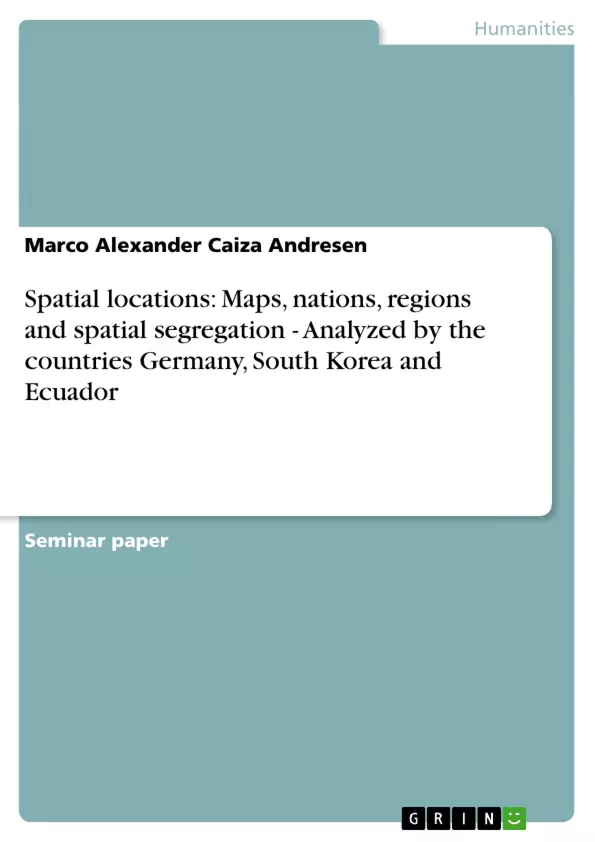This paper deals with three of the original six different topics about spatial locations. Namely, Maps, Nations and Regions and Spatial Segregation. The whole analysis refers solely to three countries: the Federal Republic of Germany, the Republic of Korea and the Republic of Ecuador. Nevertheless, following the example of Carol Delany in her book "Investigating Culture", the most important and most specific examples of these topics of spatial locations within these countries will be given – focusing on concrete examples.
The aim of this term paper is to analyze the three countries from three different continents regarding their specific understandings of their map, their nation(s), their region, and spatial segregation inside the country. Thus, one can say that the content of this work refers to the historical part of space / spatial locations within these countries. After an introduction, in the main part, beginning with the description of the countries’ maps the analysis starts with the actual situation of the countries’ borders, meaning how these countries are geographically located in the world community and how they see themselves there today. Following, an analysis of the creation of the nation in connection with the region where this nation, or these nations, are located will be given, before under the last point of the main part the most important country-specific aspect of spatial segregation within the history of each of these countries will be examined. The result of the whole comparison – cultural equalities, inequalities, and similarities concerning the specific aspects of spatial locations between these countries – will be given in the conclusion of the paper.
Inhaltsverzeichnis (Table of Contents)
- I. Introduction
- 1.1 Main Topics
- 1.2 Purpose of the Paper
- 1.3 The Countries
- 1.3.1 The Federal Republic of Germany
- 1.3.2 The Republic of Korea
- 1.3.3 The Republic of Ecuador
- II. Main Part
- 2.1 Maps
- 2.1.1 The German Map
- 2.1.2 The South Korean Map
- 2.1.3 The Ecuadorian Map
- 2.1.4 Summary
- 2.2 Nations and Regions
- 2.2.1 Nations and Regions in Germany
- 2.2.2 Nations and Regions in South Korea
- 2.2.3 Nations and Regions in Ecuador
- 2.2.4 Summary
- 2.3 Spatial Segregation
- 2.3.1 Spatial Segregation in Germany
- 2.3.2 Spatial Segregation in South Korea
- 2.3.3 Spatial Segregation in Ecuador
- 2.3.4 Summary
- III. Conclusion
Zielsetzung und Themenschwerpunkte (Objectives and Key Themes)
This seminar paper aims to analyze Germany, South Korea, and Ecuador from a spatial perspective, focusing on their map, nation(s), region, and spatial segregation. The paper uses a historical lens to understand the development of spatial locations within these countries, highlighting their unique cultural contexts and variations.
- The historical evolution of spatial locations and their significance in defining national identity.
- Comparative analysis of the concepts of "nation" and "region" within the chosen countries.
- Examination of spatial segregation patterns, including the factors contributing to their formation.
- Cultural differences and similarities concerning spatial locations across Germany, South Korea, and Ecuador.
- Highlighting the specific aspects of spatial locations that are unique to each country.
Zusammenfassung der Kapitel (Chapter Summaries)
- Introduction: This chapter introduces the three countries under study: Germany, South Korea, and Ecuador. It outlines the main topics of analysis - maps, nations and regions, and spatial segregation – and explains the purpose of the paper. The chapter also provides brief background information on each country, including their geographic location, population, ethnic groups, and economic characteristics.
- Maps: This chapter analyzes the map of each country, focusing on their geographic location and how they perceive themselves within the world community. It discusses the historical development of each country's borders and how these borders have shaped their spatial identity.
- Nations and Regions: This chapter examines the relationship between the nation and its region, exploring how these concepts have been shaped by history, culture, and geography. It analyzes the specific understandings of "nation" and "region" within each country, highlighting both similarities and differences.
- Spatial Segregation: This chapter examines the issue of spatial segregation within each country. It discusses the historical and social factors that have led to these patterns of segregation, focusing on the specific examples of Germany, South Korea, and Ecuador.
Schlüsselwörter (Keywords)
This research paper focuses on the spatial dimensions of nations, regions, and maps, examining their historical development and cultural implications. It explores spatial segregation patterns, analyzing the factors that contribute to their formation and impact on society. The key themes include: spatial locations, national identity, regional diversity, historical perspectives, and cultural comparisons. The study focuses on the Federal Republic of Germany, the Republic of Korea, and the Republic of Ecuador, highlighting their unique experiences with spatial locations.
- Citar trabajo
- Diplom-Kaufmann, M.A. Marco Alexander Caiza Andresen (Autor), 2004, Spatial locations: Maps, nations, regions and spatial segregation - Analyzed by the countries Germany, South Korea and Ecuador, Múnich, GRIN Verlag, https://www.grin.com/document/73821



